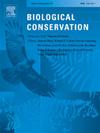中国首批国家公园生态保护效果与溢出效应定量评价
IF 4.9
1区 环境科学与生态学
Q1 BIODIVERSITY CONSERVATION
引用次数: 0
摘要
国家公园保护效益及其溢出效应对国家公园的规划、建设、评估和管理至关重要。本文采用阈值回归和倾向得分匹配方法,定量评价了中国第一批国家公园在生境质量、人为改造和森林覆盖方面的保护效果和溢出效应。结果表明,国家公园的保护效果和溢出效应存在显著的异质性。国家公园内大部分保护指标的保护效果都很好,没有<; 7.51%。与国家公园不同,外溢区保护效果较弱,最低为2.70%。此外,还观察到溢出转移带来的负溢出效应。人口密度和道路密度对外溢效应的负面影响普遍存在阈值现象,超过这两个阈值后,负面影响增加了10% ~ 437%。人为压力的空间分布差异导致国家公园的保护效果和溢出效应存在差异。这促使我们在分配保护措施时综合考虑生态指标和人为压力。本研究为评价国家公园保护效果、制定保护目标和完善保护措施配置提供了理论指导和方法参考。本文章由计算机程序翻译,如有差异,请以英文原文为准。
Quantitative assessment of ecological conservation effectiveness and spillover effects of China's first group of national parks
National parks conservation effectiveness and its spillover effects is vital for the planning, establishment, assessment, and management of national parks. In this study, we used threshold regression and propensity score matching to quantitatively assess the conservation effectiveness and spillover effects of China's first group of national parks on habitat quality, human modification and forest cover. The results showed a significant heterogeneity in the conservation effectiveness and spillover effects across the national parks. Most conservation indicators in the inner areas of the national park achieved excellent conservation effectiveness, with no <7.51 %. Unlike within national parks, spillover areas exhibited weaker conservation effectiveness, with a minimum of 2.70 %. Moreover, negative spillover effects caused by spillover transfer were observed. Threshold phenomena were prevalent for the negative impacts of population density and road density on spillover effects, and crossing them increased negative impacts by 10 % to 437 %. Differences in the spatial distribution of anthropogenic pressures have resulted differences in conservation effectiveness and spillover effects across national parks. This prompts us to comprehensively account for ecological indicators and anthropogenic pressures in the allocation of conservation measures. This study offers theoretical guidance and methodological references for assessing conservation effectiveness, setting protection goals and improving the allocation of conservation measures in national parks.
求助全文
通过发布文献求助,成功后即可免费获取论文全文。
去求助
来源期刊

Biological Conservation
环境科学-环境科学
CiteScore
10.20
自引率
3.40%
发文量
295
审稿时长
61 days
期刊介绍:
Biological Conservation is an international leading journal in the discipline of conservation biology. The journal publishes articles spanning a diverse range of fields that contribute to the biological, sociological, and economic dimensions of conservation and natural resource management. The primary aim of Biological Conservation is the publication of high-quality papers that advance the science and practice of conservation, or which demonstrate the application of conservation principles for natural resource management and policy. Therefore it will be of interest to a broad international readership.
 求助内容:
求助内容: 应助结果提醒方式:
应助结果提醒方式:


